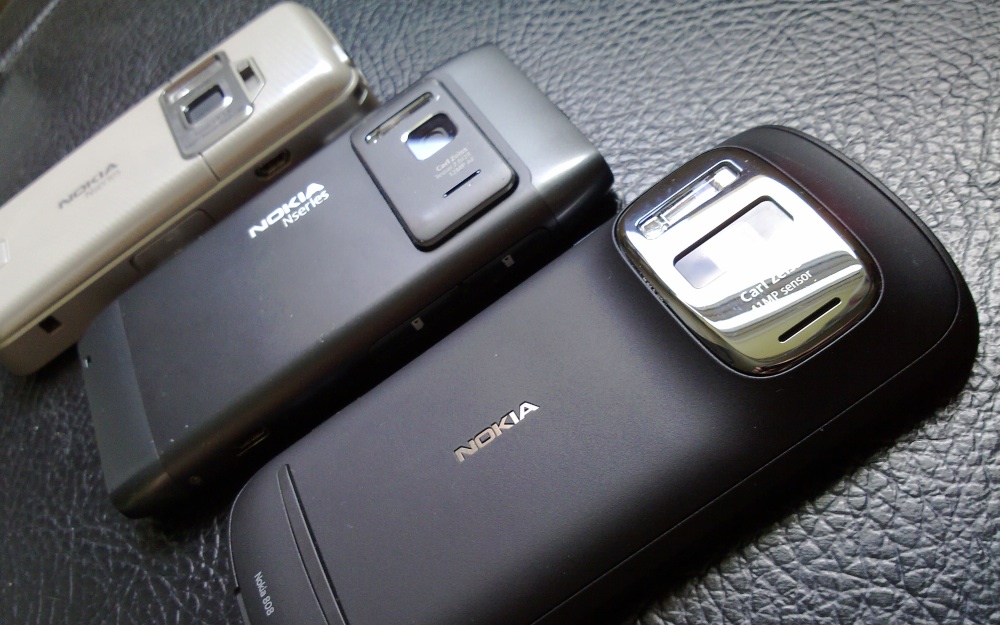
So we've established that the 808 is a great piece of hardware and a worthy last chapter to the book of Symbian, and we've established that the photos and videos it takes can be stunning and with unrivalled flexibility in terms of light, zoom levels and resolution. On the camera side of things, it claims to be better than the N8, its predecessor, and I don't think anyone would dispute that. But the questions on my mind were:
- how much better than the N8 is the 808 PureView's camera? Worth shelling out for a whole new device?
- on the camera front, how do the 808 and N8 compare to competing Android and iOS smartphones? We're all expecting the 808 (and, probably, the N8) to win, but again, by how much is it superior? Is the difference worth worrying about?
- relatively speaking, how far have we come from the 808's earliest direct ancestor, the N82, the first camera-centric smartphone with Xenon flash?
With all that in mind, some head to head photo comparisons were definitely in order. But listen up - we're talking about smartphone cameras that are the best of the best. Simply snapping flowers and lakes and churches in the sunshine isn't good enough, everything I'd test would do well under good light conditions and the only differences in quality would be down to raw sensor resolution.
Therefore, I wanted every test photo in the suite below to present a real challenge to all the smartphone cameras tested. Low or artificial light, hard to make out details, extremes of focus, extremes of light and dark against each other, and so on. All for a range of subjects at different distances.
To represent the 1/3.2"-sensored competition, I ended up with the HTC One X and the One S, both ostensibly with the same camera unit, in case you were wondering. Yes, an Apple iPhone 4S would have produced slightly less 'sharpened' outdoor shots in the sun, but most observers reckon that the One X/S is the Android powered camera combination to beat in low light and challenging situations. Note that, among other attributes, the HTC phones have variable brightness LED flash, which helps in close quarters.
To fulfil my need of challenging subjects, I headed for The Museum of Berkshire Aviation (also on Twitter) and also some of the roads surrounding it. Plenty of interest to snap, with plenty of detail, a lot of it indoors in very mixed lighting.
In some cases I was interested in how the three Xenon-equipped Nokia imaging flagships fared against each other, in others I was looking more at the 808 PureView explicitly against the best of the competition (i.e. the One X), still all in 'challenging' light circumstances, I was trying to push these cameraphones into showing up weaknesses.
Test 1: Herald cockpit detail

Inside the plane, shooting extreme dial details in the cockpit, with no internal lighting and with everything in shadow compared to the light from the windows up top. From top to bottom here are relevant crops of the photos from all three phones: N82, N8, 808 using the default 5MP PureView mode, zoomed right in:
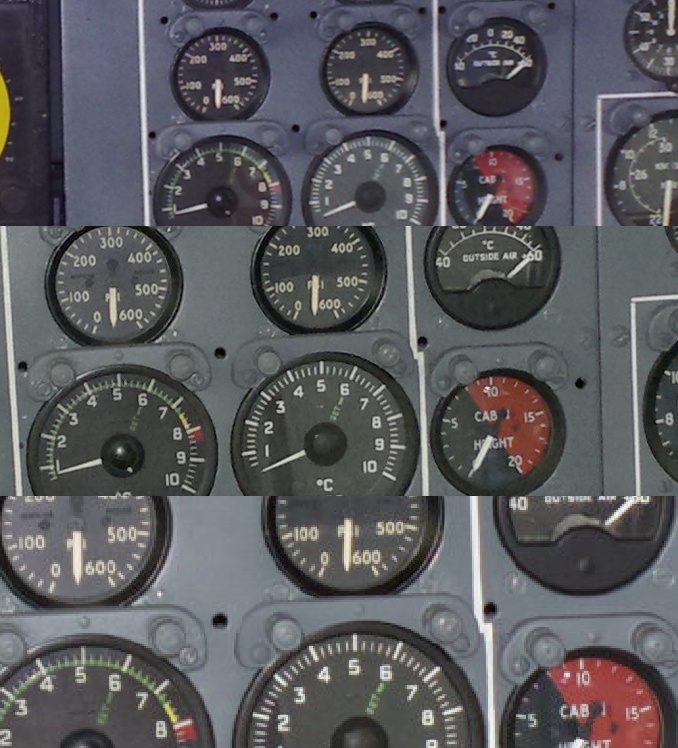
What I find interesting here is that, although the N82's smaller and older sensor is clearly inferior, the N8's 12MP photo crop in the centre is crisper and more accurate than the 808's 5MP PureView-zoomed version. Not least because at maximum zoom, the PureView noise reduction isn't in play. There is slightly more detail in the 808's image, but the takeaway from this first test is just how good a job Nokia did on the N8 camera!
Moving on...
Test 2: Models, gloomy light, through glass
In this case a rather nice WWII glider scene, shot through the display glass without flash (obviously):

A really tricky shot to get, not least because I had to pick a focus point, in this case the nose of the first glider. From top to bottom, crops from: N82, N8 in default 12MP resolution, 808 in default 5MP PureView mode:
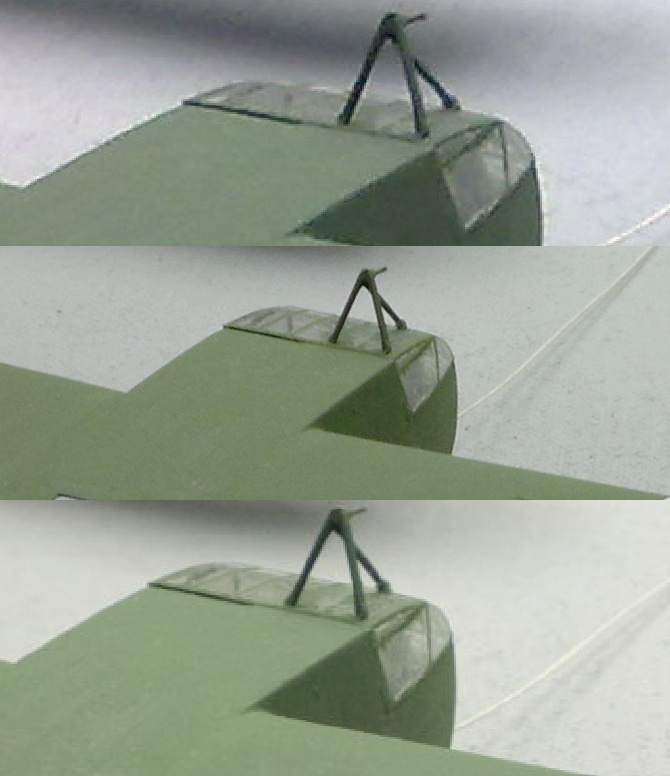
I know what you're going to say here - and you're right. The N8's photo is crisper and more detailed, but then it's being shot at 12 megapixels - the 808 was here left in default 'Automatic' 5MP mode, in which case the comparison should really be to the 5MP photo being shot by the N82, top. Whereupon you can see the advantages of the 808's larger sensor and PureView oversampling in terms of maximum detail for the resolution.
Nokia claims that the 5MP PureView mode in the 808 brings out as much (if not more) detail than 8MP images on competing smartphones (e.g. the HTC One X, of which more later). That may indeed be true, but it's immediately evident to me that however 'pure' a 5MP image is, it can't compete with detail from an excellent 12MP photo.
Test 3: indoor light, distant object
A real test of sensor and optics, a detailed sign on a wall around 50 metres away, in indoor/indirect light:

In each case I did my best to focus on the sign, and took several photos with each phone, picking the clearest here to crop. From top to bottom, crops from: N82, N8 in default 12MP resolution, 808 in default 5MP PureView mode but zoomed right in:
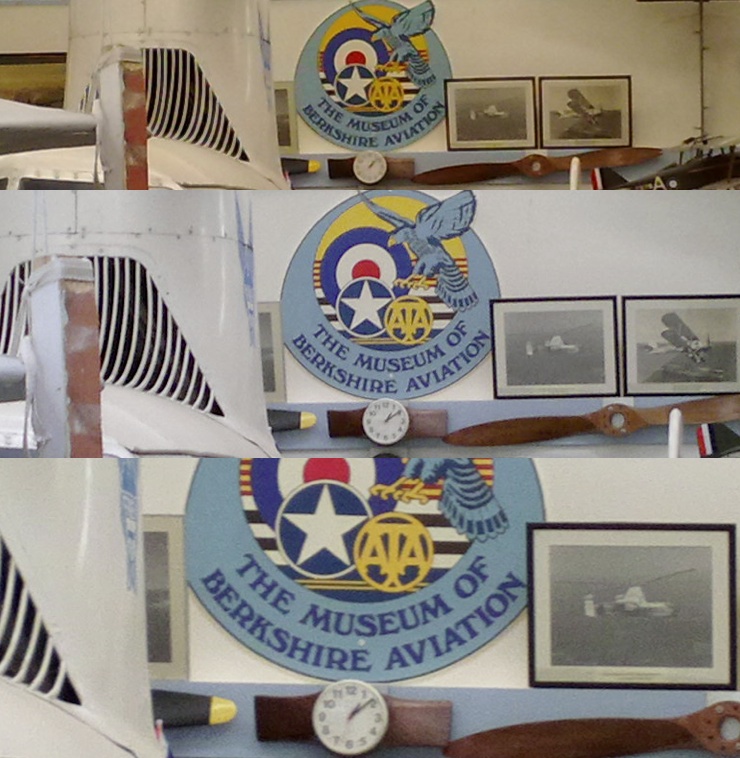
Again we have two comparisons going on - the 808 versus the native 12MP resolution of the N8 - the bottom crop of the PureView zoomed image does have significantly more detail than the N8's crop, even though it doesn't look as 'crisp' to the naked eye. There's also slightly more noise because the effective pixel size is now smaller (i.e. there's no oversampling going on), but at least the user can see the benefit of the zoom visually to some degree.
The comparison to the native 5MP image of the N82 is marked - it's as if you could describe the 808 PureView as having a 5MP camera that can resolve more detail than the 12MP N8 when needed (i.e. when zoomed), with the benefit that everyday snaps will be cleaner and clearer.
Test 4: Poor light, picking out detail
Another real test of sensor and optics, detail inside an engine exhaust, about a metre away, indoor/indirect light, no flash allowed:
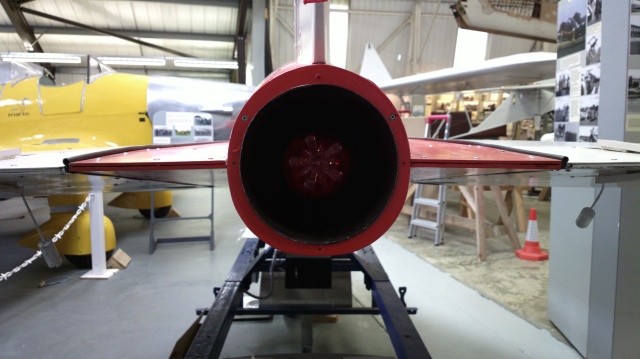
From top to bottom, crops from: N82, N8 in default 12MP resolution, 808 in default 5MP PureView mode:
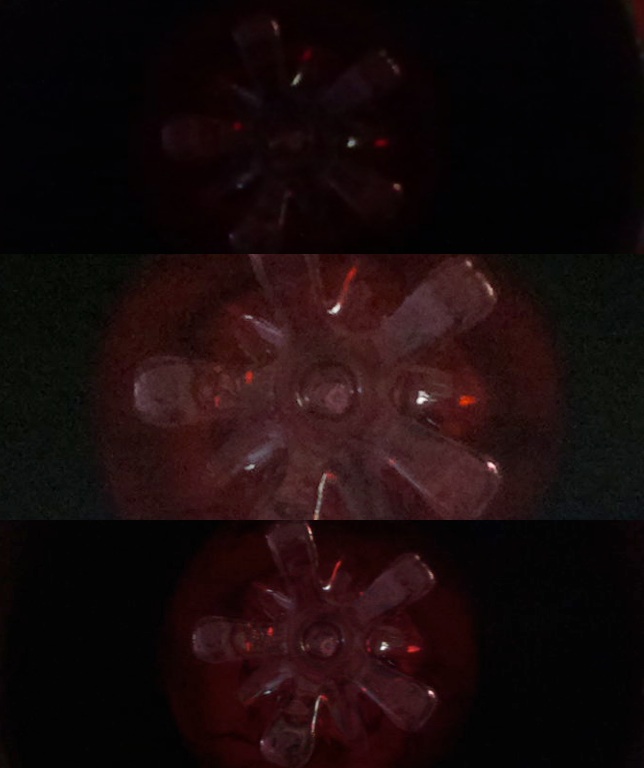
A great example of the way PureView works. The middle shot shows the extra pixel detail and extra light gathered for the N8 when compared to the smaller N82 sensor, but there's lots of digital noise and colour uncertainty. The bottom crop, at much lower resolution but in PureView mode, shows far better colour consistency and, arguably, more pleasing detail. In a real world photo, I'd have been tempted to zoom in a little way on the 808, to bring the size of the core subject up in a final frame/printout, while still preserving much of the oversampling benefit.
Test 5: Static indoor shot, 2 metres, flash allowed
Enter Xenon flash, with a wall mural with intricate flower patterning, shot a couple of metres away on a tripod:

From top to bottom, crops from: N82, N8 in default 12MP resolution, 808 this time in 8MP PureView mode:
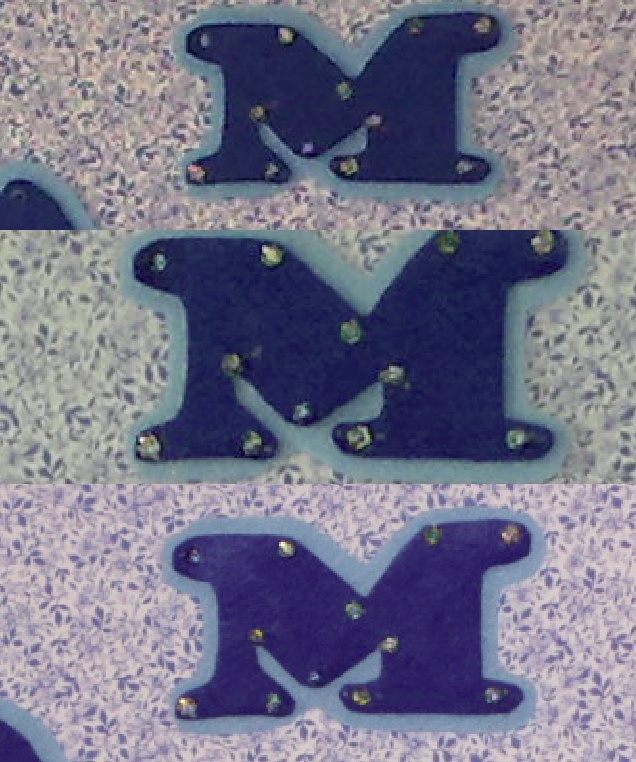
Another good example of the way PureView works. The N82 crop has reduced the flower pattern to something resembling sensor or JPG artefacts and the 'M' edges and testure are unsatisfactory. The N8 crop is more detailed, as you'd expect from 12 megapixels and you can start to see the flowers, plus there's some detail on the jewels. But the 808 PureView crop blows the other two away, here in my favourite 8MP PureView mode, showing the flower pattern almost perfectly, plus smooth edges to the 'M' and the colour of the whole design is also spot on.
Time to introduce a competing smartphone camera into the mix. In this case the HTC One S (shots from the identically-equipped One X later in this piece)....
Test 6: Detail from a mid-range object
In this case, focussing on the rotor at the top of the Fairey Jet Geodyne (a full decade or two before Airwolf?!):
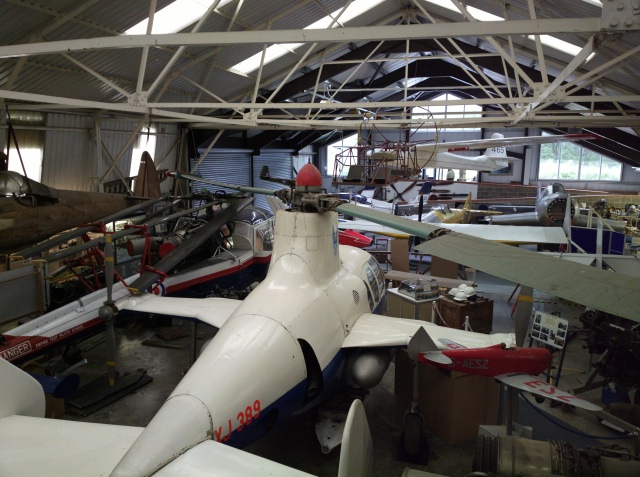
Clockwise from top left: N82, N8, 808 in 38MP mode, HTC One S:
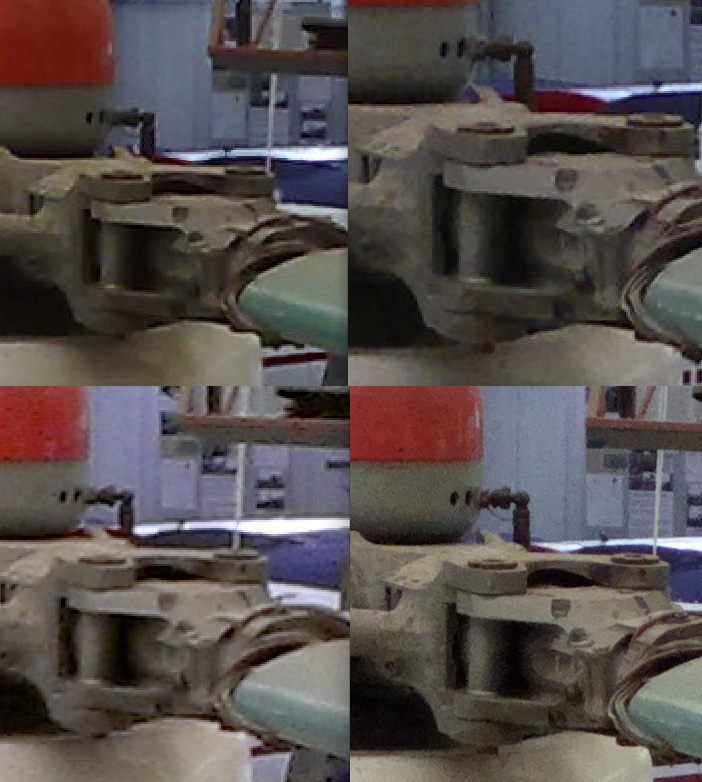
The first takeaway here is that the five year old Nokia N82 with its 5MP sensor produces better results than the 2012 HTC One S with its 8MP sensor. The difference is surely the Carl Zeiss optics in the Nokia - this is the difference it makes. I did note this at the time, and even wondered if the One S was faulty in some way, which is why I switched to the One X for most of the rest of the comparisons here.
We then have the more detailed N8 crop and the even more detailed (albeit slightly noisy) Nokia 808 38MP crop. This shows what the raw sensor can do, even if you do have to jump through hoops to cut images down later to manageable size.
Test 7: Indoor, artificial light, pub shot
Retiring to the local hostelry, I met up with James Honeyball and Trevor Bennett. Recruiting them as actors(!), I then shot them doing the same action over and over again, i.e. moving their glasses to clink together to say 'cheers'. So we've got moving subjects in poor light. This is the typical pub/party shot and it's also where the Xenon flashes of the three Nokias should (literally) shine.

Again, clockwise from top left: N82, N8, 808 in default 5MP 'auto' mode, HTC One S:
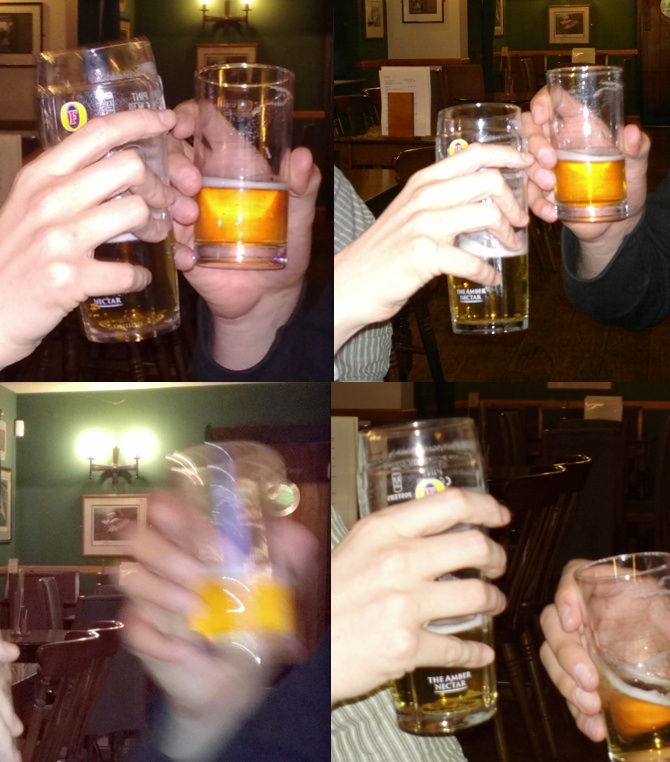
I found it hard to split the N82, N8 and 808 shots here, Xenon flash did a great job of freezing the motion in each case. The HTC One S has to slum it with LED flash, with predictable results. This is why photos from 95% of the world's camera phones are complete rubbish at parties and events. If I had to pick a winner, it might be the N8, because its default resolution is higher and there's more room for trimming or cropping a party snap later on. Then again, the N82 and 808 have stronger flashes, so would be better in a true group shot, where people were further away. So honours even all round for this popular use case.
________________
I have to say that I was surprised by the performance of the 'old' 5MP N82 - I'd forgotten just how good this was, often outperforming the 8MP competition of today, thanks to the Carl Zeiss optics and the protected camera glass, ensuring that there are no finger smudges or dust in the way. Considering you can pick up N82s now for £50 or so, I'd recommend keeping your eyes open for a bargain back up camera phone.
__________________
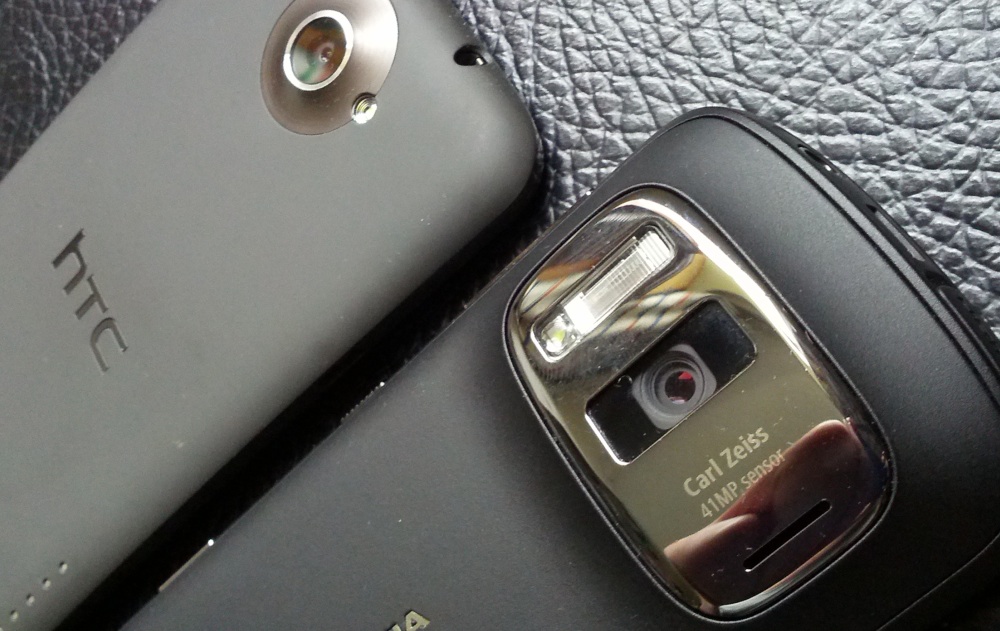
Let's stay with 2012 phones though, in particular putting the HTC One X, reputedly with the best non-Nokia camera in poorish light conditions, against the 808 PureView directly. Again, I'm not expecting the One X's camera to beat the 808 in any area, but I'm interested in the margin of victory in each case.
I'm also interested in how genuinely useful the PureView zoom is in real world situations, i.e. how much more detail gets resolved by abandoning the oversampling and going for straight out, maximum zoom, raw sensor resolution detail. So, in the comparisons below, we've got three crops each. On the top is a crop of the scene from the One X, in the middle is a crop from the 808 in 8MP PureView mode and at the bottom is a crop from the 808 in 8MP mode but full zoomed in.
Test 1: Average light, detail in middle distance
With overcast conditions, I wanted to really stretch the resolving power of each sensor - remember that we're running the One X and the 808 each time in the same 8 megapixel resolution, so we're 'comparing apples to apples' here. Here's the wider scene:
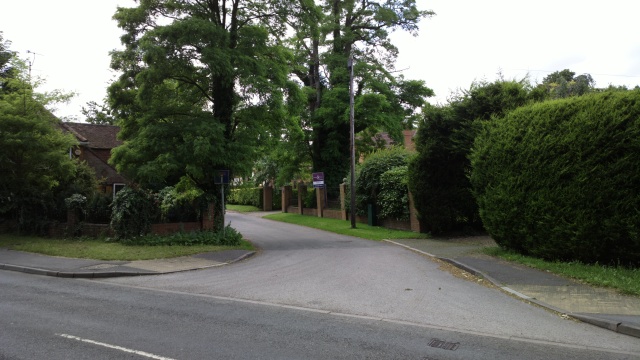
I was focussing on (literally and figuratively) the small 'SOLD' sign on the property halfway along the road. From top to bottom, here are the crops. Again, HTC One X, Nokia 808 8MP PureView, then the latter but zoomed in using the PureView lossless zoom, taking us down to 1:1 pixel use on the sensor:
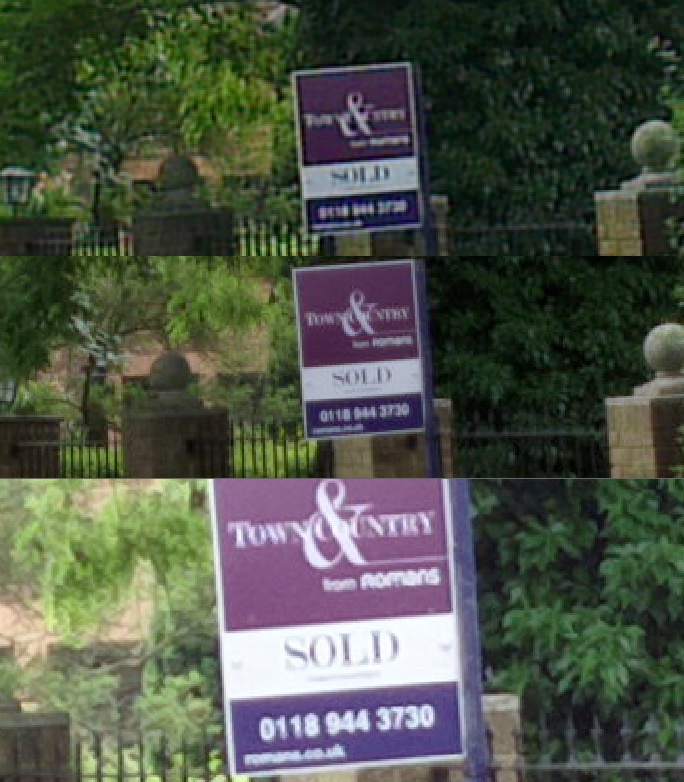
First of all, the difference between the top two crops, both at the same 8MP resolution. Nokia has gone on at length about the way the PureView' system produces 'perfect' pixels and thus ends up resolving more detail than other cameras of similar nominal resolution - this comparison shows this up well. Look at any detail in the top two crops, e.g. the ornamental ball, bottom right, and you'll see more detail and clarity. Look at the sign itself and the difference is dramatic - text is readable and clean and there are no ugly artefacts. PureView in action, indeed.
Now look at the difference between the second and third crops. When you use the PureView zoom, you lose the benefits of the oversampling/super-pixels. Thus the third crop has more digital 'noise' and isn't so satisfactory from a point of view of clarity and colours. However, there is more detail available for inspection - perhaps not three times more (as you might expect by zooming in by a factor of 3), but slightly more. As to whether it's worth zooming in for real world shots or whether to hang back to have the 'pure' images, I'd say that you should simply use the zoom as you feel framing each subject warrants, i.e. use it creatively, and not worry too much about it. Stay unzoomed and you'll gain fabulous picture quality - zoom in a bit and you get more detail and some oversampling - zoom in a lot and you get maximum resolvable detail, but either way you'll be pleased with the results.
Test 2: Extremes of light and dark, detail in the latter
With the sun now out, I focussed on a doorway in the shade around 40 metres awat. Here's the wider scene:

You'll see from the degree of cropping below how much stress I'm putting these phone cameras under! From top to bottom, here are the crops. Again, HTC One X, Nokia 808 8MP PureView, then the latter but zoomed in using the PureView lossless zoom, taking us down to 1:1 pixel use on the sensor:
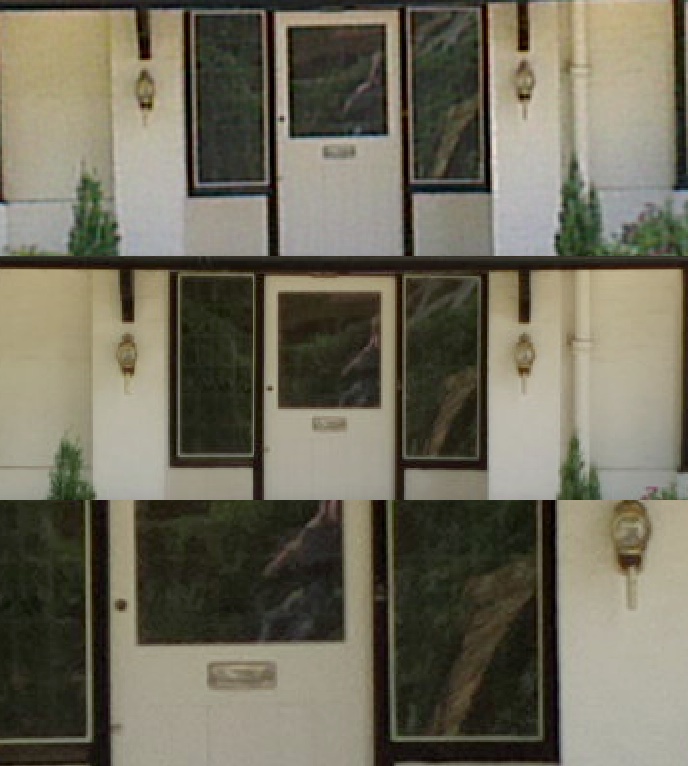
With overall light levels fairly high and with highly geometrical subject detail, the One X's camera fared a bit better here, but everything in its photo is still noisier, less precise and uglier than the 8MP PureView crop in the middle. Just look at the drainpipe on the right, for example, plus the purity of the colour of the wall beside it.
As before, the bottom crop gives extra detail (as you'd expect from using raw pixels on a 38MP sensor) - see the wall ornaments, for example. Again, detail at the expense of purity and only you and your knowledge of what you want from the photo can determine which is 'best'. For example, are you planning to print it as-is, or crop a portion out and then print that, is it for web use, for TV/projection, and so on?
Test 3: Very low light, subject a 1 metre
The HTC One X is, away from Nokia cameras, the undisputed king of the smartphone camera world in low light conditions, so let's put it to the test as far as I'm able. In this case a print of a painting in a gloomy room indoors, taken at about 1 metre distance with no flash allowed (so as to even the playing field). Here's the wider scene:
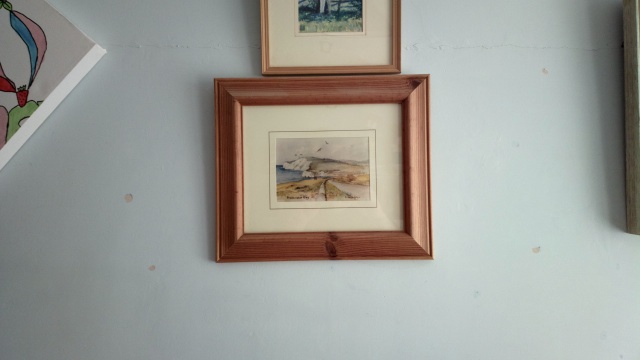
With no flash allowed, we're looking at the capability of the optics and sensor - remember that the One X camera has the much-feted 'Back Side Illumination' system. From top to bottom, here are the crops. Again, HTC One X, Nokia 808 8MP PureView, then the latter but zoomed in using the PureView lossless zoom, taking us down to 1:1 pixel use on the sensor:
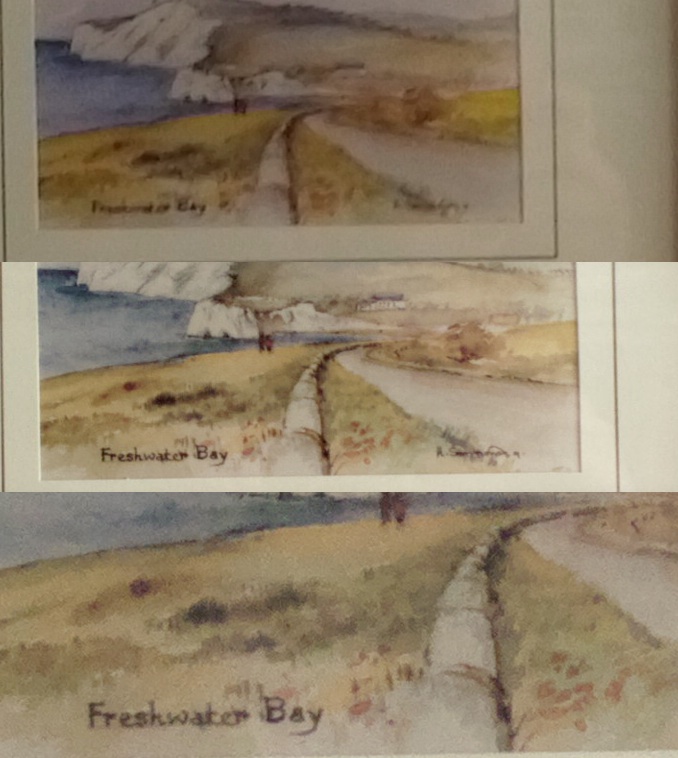
The use of water colours in the original painting, means that most of the details are somewhat blurred by design (ahem), but we can thankfully look at the painting's title, "Freshwater Bay" (anyone else been there?) Despite the use of BSI, the One X's camera completely let me down here, with blurred and ugly detail - you can't even read the title if you didn't know what it said beforehand. On the other hand, in the 8MP PureView version, the print's frame has too white, paler than it is in real life, but all is forgiven in terms of clarity and detail.
As before, the zoomed in version adds a little detail - but not that much and at the expense of seeing the raw sensor noise and uncertainty.
_________________________
Conclusions from the three thousand words and dozen or so examples above? Let's put it in simple bullet point terms:
- Even the 2008 Nokia N82 camera is still comparable with, and in some situations superior to, the cameras in today's non-Nokia flagships (e.g. iPhone 4S/Galaxy S III/One X)
- The 2010 Nokia N8 camera is still significantly ahead of the non-Nokia competition
- Used with default (9MP crop of the 12MP sensor) settings, the native resolutions on the Nokia N8 can often (depending on light) produce more detailed, clearer photos than the 808 PureView using its 5MP default. Partly this shows how good and high specification the N8 was/is, partly this is down the low resolution default chosen by Nokia for the 808.
- Set to 8MP PureView mode in particular, the Nokia 808, in my opinion, produces better, more detailed photos in all light conditions than any phone on the planet.
I've been finding that I've been (by far) happiest with the 808 by using it in 8MP Creative mode, with the following settings (all thankfully remembered from one camera session to another):
- 'PureView' ON
- 8MP
- 16:9
- Superfine
- Vivid
(and everything else on defaults)
There will be much more on camera settings and defaults in part 2c of my ongoing review of the Nokia 808 PureView. Coming very soon.
Reviewed by Steve Litchfield at
No hay comentarios:
Publicar un comentario